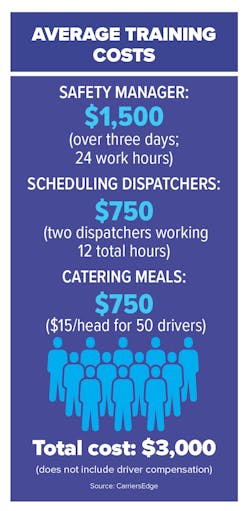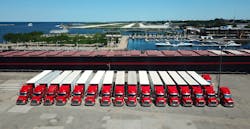It’s over. After more than a year of mask mandates and social distancing due to the COVID-19 pandemic, the trucking industry can creep toward some semblance of normalcy. Trucking stakeholders, from fleet leaders to manufacturers can once again meet in-person at events and catch up on everything that's been missed: shaking hands, checking out new equipment, discussing critical issues, and then clinking drinks and spilling tea afterward. You know, human stuff.
Normalcy doesn’t mean complacency, though. There is an incredible amount of rebuilding to do. There’s no telling how much was lost or broken while the world hunkered down to avoid this pernicious coronavirus. The reported death toll for the U.S. was just under 600,000 as of early June, but even that doesn’t come close to quantifying the social, political, and economic tolls paid since early 2020. The trucking community will need to be at full strength to aid in the recovery efforts, and that means everyone involved will need to have the most up-to-date knowledge to do their jobs safely and efficiently.
The good news is that during the pandemic, fleets, shops, OEMs, and solution providers all stepped up to roll out more virtual training, from remotely onboarding new hires and introducing the latest trucks and components to continuous education and coaching for veteran drivers and technicians. Online training provider Luma, for example, saw an increase of 60% for its interactive teleconferencing solution, Luma Live System May 2021 versus May 2020. Combined with the irreplaceable aspects of in-person meetings and hands-on product demonstrations, trucking now has a formidable one-two punch to quickly knock out nearly any type of training needed in the industry. This also allows for more flexibility in the education process, allowing a customized approach that appeals to a diverse set of learners.
And what a blended approach can really provide is a more efficient use of time and resources, which plays to what profitable fleets do best. The same tactical attack used on route planning, utilization, and fuel consumption should also be applied to the people operating the equipment.
“Sometimes putting people together in an interactive session is great; sometimes giving them self-study content is great as well—and people have sort of started to figure out how to balance those things,” Mark Murrell, CarriersEdge co-founder and president, told FleetOwner. “The best practice is having a blended strategy that incorporates different types of learning delivery—live, virtual and self-study.”
CarriersEdge provides online training solutions and itself is a completely virtual company. Murrell warned switching to a digital-only training environment is as foolhardy as keeping everything in-person.
On the flip side, “doing everything in a classroom is inefficient,” Murrell noted, citing the costs of bringing in many students for several days of training.
By CarriersEdge calculations, a single driver’s meetings at a physical location can cost $3,000, which includes 36 hours of labor for the safety manager and dispatchers to schedule and plan the session. Catering alone may run $15 a mouth. Tack on driver pay for attending and safety training, while incredibly important, becomes so costly it’s possible fleets may reduce their frequency, leading to a diminished safety culture.
For driver onboarding and orientation, which includes travel and lodging, Murrell estimated a blended approach can conservatively cut 25% of total costs. He cited intangibles such as higher retention and shorter time to productivity as benefits of online learning.
“It allows fleets to shorten the total days at the terminal required for new hires,” he said, explaining that the drivers like this method, which can lead to better retention, while fleets get those drivers on the road faster for improved productivity. “Moving orientation online also allows the fleet to focus the in-person (training) on stuff that’s specific to the company or team building, which is much higher value.”
Moving to a more efficient training strategy that yields the same or better results also shows drivers that fleets value them.
“Dragging them off the road or dragging them in on a weekend to sit in a classroom is stupid,” Murrell asserted. “The business is not making any money, and drivers only make money when they're moving. And if they're not moving, they should be home having time off.”
Digital pivot
One CarriersEdge customer called Upstaging found there is more value in moving all training online. The medium-sized fleet delivers lighting, power, and other materials and resources for live events such as concerts and World Wrestling Entertainment. Because of its role transporting equipment for the music industry’s top acts, the company, which also manufactures lights, was hit hard by the pandemic shutdowns. The company pivoted to third-party logistics to haul emergency goods to remain profitable, but that created a giant vacuum in the regular training routine.
According to Chip Warterfield, fleet safety manager for Upstaging, all training would be done after the two dozen or so trucks would arrive at a venue.
“All of a sudden, we've got 150 people scattered all over the map; no two people are in the same place,” he said.
At the start of the pandemic, Warterfield would have to track down drivers when they visited the facility in Sycamore, Ill., to watch safety DVDs.
“They were not thrilled about that aspect at all,” said Warterfield, who has 40 years of driving experience himself. “Drivers moved into a stealth mode, showing up in the middle of the night, so that they didn't get captured by the safety department to sit down and do training.”
This made engagement more difficult, and safety is of paramount concern to Upstaging as any accident, however minor, would reflect on the client. “Headlines wouldn’t read ‘Upstaging truck hits bridge. It would be ‘Taylor Swift truck hits bridge,’” Warterfield explained.
Lack of driver engagement also risked alienating its high-value pool of talent. Upstaging has single-digit turnover and only hires the top 1% of applicants.
Warterfield found CarriersEdge had the training modules on hours of service (which changed last fall), defensive driving, bridge formulas, and weights and measures. Now Warterfield could track progress more easily, how long they spent on each question, and identify questions that everyone missed, and therefore, where training needs to be improved. “The dashboard allows us to see where drivers’ strong suits and weak points are, and then we can add additional training and input into our newsletters to help the drivers get better versed in certain subjects,” he said.
Online onboarding and coaching
On the large fleet side, Schneider National found that virtual onboarding provided a more efficient use of trainers. The nationwide logistics carrier has about 13,500 drivers, and with turnover across the industry regularly over 80%, Schneider must onboard several thousand new drivers annually. With their current virtual system, one lead trainer will connect with drivers at training academies across an entire time zone. For instance, a trainer in Atlanta would be in sessions with drivers in Pennsylvania, Indiana, and North Carolina.
There is still a classroom assistant in each classroom, but it frees up the most experienced trainers to provide in-cab coaching at those sites. That was made more difficult when social distancing rules prevented more than one student in a truck at one time.
Schneider also relaxed rules for veteran drivers.
“If you are coming to us with driving experience, instead of going through what would be about a five-day program, you could take all your work virtually and then come in for one day of road work in-person,” explained Tom DiSalvi, Schneider vice president of safety, driver training, and compliance.
Through this method, Schneider has also ensured more consistency in the curriculum across its network, he said.
The fleet also had to address how to provide continuous education to current drivers on topics such as HOS and trip planning, moving to phone coaching. Before the call, the driver would be provided with online study materials.
“By being able to provide a video to the driver in advance as pre-work, and then a phone conversation with them, we were able to not only be effective but efficient, too. And they didn't need to come into our location to do that,” DiSalvi said.
Schneider has also begun a pilot program with Platform Science tablets in the cabs to perform video coaching. This allows an extra layer of personal connection along with the ability to share screens. This provides instant feedback that would not be possible on a phone call.
“If someone's having a difficult time getting into a customer, we can share the Google map with them (when they are pulled over) and say, ‘Here's how you go around,'” DiSalvi said.
When needed, a driver can still be brought in to talk, but that is no longer the first and only solution, he said.
Initial data showed that the new blended strategy has not been a detriment to safety. DiSalvi reported that overall, Schneider’s safety metrics “were as good and in many cases better” during the pandemic.
About the Author
John Hitch
Editor
John Hitch is the editor-in-chief of Fleet Maintenance, providing maintenance management and technicians with the the latest information on the tools and strategies to keep their fleets' commercial vehicles moving. He is based out of Cleveland, Ohio, and was previously senior editor for FleetOwner. He previously wrote about manufacturing and advanced technology for IndustryWeek and New Equipment Digest.




